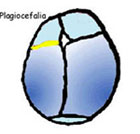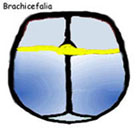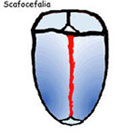Monday, February 28, 2011
: when the children always sleep on the same side;
brachycephaly
: when they sleep always face up, and
before the party Infant Jesus of Rome, leading a work based on the integration of diagnostics and treatment of disorders of postural aged 0-18 years, with osteopathic palpatory diagnosis and osteopathic manual techniques. According to a research
Source: Tuttosteopatia Papers
scafocefalia
: when they sleep with his head always to one side), the term plagiocephaly is the most widespread and is generally used to describe all three types of irregularities of the skull.
premature fusion of coronal suture early fusion of both coronal sutures
 early fusion of the sagittal suture early fusion of the sagittal suture |  |  | Among the main causes, those pre -born and those which arise during childbirth.
premature compressive forces intrauterine
are the most common cause of cranial irregularities. Inside the womb the fetus could be restricted in movement, and be forced in the same position for a period of time. The position of the head and neck, long maintained, associated with the softening of the bones, cranial deformation tend to cause a headache and an imbalance of the neck muscles (particularly the sternocleidomastoid). After birth, the baby will tend to prefer the same position retained in the uterus, causing a bad experience cranial deformities. during childbirth
are the most common cause of cranial irregularities. Inside the womb the fetus could be restricted in movement, and be forced in the same position for a period of time. The position of the head and neck, long maintained, associated with the softening of the bones, cranial deformation tend to cause a headache and an imbalance of the neck muscles (particularly the sternocleidomastoid). After birth, the baby will tend to prefer the same position retained in the uterus, causing a bad experience cranial deformities. during childbirth
ectopic compressive forces
A traumatic birth, for example due to the use of forceps or suction cup. - VIEWS OSTEOPATHIC
- The osteopath has a very high percentage of complete success in cases of positional plagiocephaly. "The plagiocephaly - according to an article published
Manuela Emili
- is accessible through a structural component in the inaccessible neurological factors can be influenced and changed."
According to a study of 649 children examined with osteopathic approach - , osteopaths
- Nicette Sergueef along with Kenneth E. Nelson, Thomas Glon, determined that a thorough neonatal osteopathic examination can identify individuals predisposed to develop a posterior plagiocephaly.
own conduct in the department of pediatric surgery in the garrison Palidoro, cranial sacral osteopathic treatment may have in cases of plagiocephaly, an indication of choice, the aim was to show how the palpatory diagnosis osteopathic can integrate traditional semiotics. Research has shown that about 20 children (12 females and 8 males), 2 have reported frontal plagiocephaly, 4, a posterior plagiocephaly. At the end of osteopathic treatment plagiocephaly had improved in all cases treated and documented in two cases more stringent examination RX post-treatment.
Source: Tuttosteopatia Papers
Of Nicette Sergueef, Kenneth E. Nelson, Thomas Glonek Palpatory diagnosis of plagiocephaly
palpatory diagnosis of plagiocephaly Source: Elsevier, May 2006
palpatory diagnosis of plagiocephaly Source: Elsevier, May 2006
experience of osteopathic treatment for pediatric craniosacral dysfunction: case series
-
MISCELLANEOUS ITEMS on the internet only "helmets for plagiocephaly. Let's build an alternative
. Source: Tuttosteopatia.it III National Congress FIMP. "The land of empty cradles" - manipulative treatment on infants with birth trauma: results and follow up on 250 children
Osteopathy in children
- María José Núñez Prado
Plagiocephaly posicional y su abordaje osteopathic a Traves de Tecnicas Manuales - The positional plagiocephaly and its treatment by osteopathic manual techniques Source: Osteopathic School of Madrid, in December 2000. Published on www.osteopathic-research.com
-
Subscribe to:
Post Comments (Atom)
0 comments:
Post a Comment